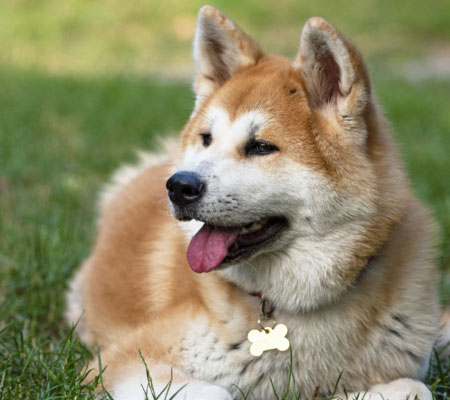The esk Fousek (pronounced 'ches-key fow-sek') is
a medium-sized hunting dog that originated in the Czech Republic, where it is
still widely used as a hunter and companion animal. Its adaptability is
well-known, and this water-dog is well-suited to a variety of tasks, both wet
and dry.
One of their most distinguishing qualities is
their gorgeous and unusual facial fur, which, along with their expressive eyes,
makes for a stunning dog. They make an excellent family companion since they
are loyal to their owner and loving to the majority of people. They have a lot
of enthusiasm and joy in life, and they enjoy being active and outside.
Cesky Fousek Highlights
Breed Size
Large
Nature
Gentle, Friendly, Playful, Outgoing, Willful
Energy Level
Active
Intelligence
High
Barking Level
When Necessary
Coat Length
Short
Breed Group
Working
Droll Amount
Low
Good with
Familes, Children, Dog
Feed Level
Medium, High
Colour Type
Rown, brown ticked, brown
Other Facts
Easy to train, easy to groom, easy to kept at home, love wate, playful with their owners.
Dog History
The esk Fousek is known by a variety of names.
The Bohemian Wirehaired Pointing Griffin, Czech Coarsehaired Pointer, and
Slovakian Wirehaired Pointer are all names for the same dog.
While it is commonly assumed that these dogs
originated in what is now the Czech Republic, nothing is known about their
specific origins. A Czech nobleman named a 'Canis Bohemicus' in a letter
published in 1348, which might have been the modern-day esk Fousek. Johann
Friedrich Von Flemming, another author, noted similar 'roughhaired dogs from
Bohemia' in 1724.
While both of these allusions are most likely to
the modern-day esk Fousek, it's impossible to be certain because the dog isn't
detailed in great depth. However, in 1883, Josef Vilém ern published
Huntsmanship - Handbook for Hunters and Hunting Friends, which clearly defines
the esk Fousek dog as a Pointer. The esk Fousek was widely regarded as the most
popular wirehaired hunter in its home country, the Czech Republic, prior to
World War I. It was also popular in neighbouring countries like as Austria and
Germany. The esk Fousek came perilously near to extinction after being
seriously damaged in World War I (as did many other canine breeds at the time).
The Association for the Wirehaired Pointer esk
Fousek, thankfully, was created in 1924 with the specific objective of reviving
the breed's popularity. They had a difficult task: the breed had been
devastated after WWII, and German and English Pointers were gaining popularity
among European hunters. The group persevered, and its breed standard was issued
in 1931. They were adamant about include only the greatest hunting dogs in the
line, and they even put potential breeding animals through hunting trials to
verify they fulfilled the rigorous criteria.
World War II, predictably, had a detrimental
influence on the breed's numbers, but the organisation worked hard to preserve
the breed alive by allowing other hunting dogs, such as the German Shorthaired
Pointer, to contribute to the breeding programme for a period. Eventually, in
1964, the esk Fousek was recognised as a distinct breed. They were so popular
in the Czech Republic the next year that they were included on postage stamps!
This is a popular breed in Europe and beyond
today. The original breeding association, which was recognised by the United
Kennel Club in 1996, is still operational today, and its members should be
proud of their accomplishments. The esk Fousek, a much-loved family pet, still
maintains its reputation as a successful hunter, whether in the woods, the
field, or on the water.
22-27 inch 28-39 kg 13-15 year
Height

Weight

Life Span
Health and Care
In general, Cesky Fousek dogs are in good health.
However, they, like many other dog breeds, are prone to specific health issues.
Alopecia, bloat, entropion, elbow dysplasia, hip
dysplasia, and osteochondrosis dissecans are some of their most prevalent
health issues. Always strive to remain in touch with a local veterinarian.
Caring
It is critical to take appropriate care of the
animals when growing Cesky Fousek dogs. Keep up with your dog's regular
veterinarian appointments to catch any potential health issues early.
When it comes to rearing Cesky Fousek dogs,
regular exercise is essential. They're ideal for hikers and joggers alike. They
require a daily, lengthy walk on days when they are not taken on a hike or jog.
The Cesky Fousek dog breed is not suited to city
living and thrives in a wide yard with an active family. A fence of at least 6
feet in height is required.
Dog Breed Care Tips and
Important Instructions
For these relentless and active creatures,
exercise is essential. They are more than capable of keeping up with even the
most active household, and they should only be kept as family pets if they will
be given lots of intense exercise. They'd be ideal for someone who hikes or
jogs.
The Cesky Fousek's coat is very easy to maintain.
Simply clean your teeth with a hard bristle brush on a regular basis and wash
only when required. The coat will shine after being rubbed with a piece of
towelling or chamois. Check the dog's feet as well, especially if he's been
exercising or working. To avoid cold, carefully dry the dog after hunting.
Examine your ears on a regular basis. This breed sheds on the average.
The Cesky Fouseks shed in a considerable amount.
It's a part of the hair's normal growth cycle. Brushing your hair on a regular
basis lowers the quantity of hair that sheds. It is mostly determined by their
health and breed type.
Average. This family dog should be groomed at
least once every 4-6 weeks, according to experts. According to a research, 56%
of dog owners don't bathe their dogs as often as they should, and 60% use the
smell test to determine whether it's bath time. Bathing your dog is good to
them in a number of ways. Look for strange scrapes, lumps, fleas, and other
anomalies now. These features are more noticeable when their hair is damp and
flat on their bodies.
Feeding
Around the age of eight weeks, a Cesky Fousek
puppy is fully free of his mother's milk. As a result, we'll assume it's
totally weaned when you adopt it.
To begin with, you're not going to modify the
puppy's nutrition all of a sudden. As a result, you'll need to speak with the
previous owner or breeder about how to handle the first few weeks. And if the
breeder used to feed him kibbles and you want to switch, you'll have to ease
into it. You can gradually introduce and mix the new diet with the old over the
course of two weeks or longer.
You'll need to feed your Cesky Fousek puppy
multiple times throughout the day:
3 to 4 meals a day for animals aged 2 to 6
months, then 2 meals a day for up to a year (and for certain Cesky Fousek, you
may continue in this manner even as an adult) to avoid stomach torsion.Rations
will need to be adjusted according to his age, race, weight, and lifestyle...
Remember to keep an eye on your puppy's
development. Indeed, it will be required to move to a "Cesky Fousek
adult" diet after it has attained 90% of its ultimate weight.
Fun Facts
- The Cesky Fousek is a kind of hunting dog.
- The Mammalia class includes the Cesky Fousek.
- The Cesky Fousek is a wirehaired pointing dog
that has been used by Czech and Slovakian hunters since before World War I.
They live with their owners on farms and in their houses.
- The 12-15-year lifetime of the esk Fousek hunting
dog breed, which has survived two World Wars.
- The Cesky Fousek dog breed has a conservation
category of Least Concern.
Home Training Tips and General
Information
A Cesky Fousek can be potty trained at any age,
but the optimal time to start is when they are between the ages of 8 and 12. If
you begin a house-training programme as soon as you bring your Cesky Fousek
puppy home, he will quickly learn where he should relieve himself. Potty
training a Cesky Fousek puppy is a breeze with a crate. When there is no
direction, it keeps him confined, and most pet Cesky Fouseks quickly learn that
if they go into their box, they will be forced to sit in it. Many dogs are
relatively sanitary and will despise having to sit in dog faeces or pee.
Make sure there's enough room in the cage for
your Cesky Fousek puppy to spin around, but not so much that he can go outside
and rest. Many Cesky Fousek owners consider a box to be a jail cell or a means
of punishment, but your Cesky Fousek will appreciate having his own area where
he can escape away from the family's tension for some quiet time. Make your
Cesky Fousek's box a joyful place to visit rather than a place of punishment.
You may feed your Cesky Fousek in the cage or give him snacks while he's in
there.Include a favourite chewy or toy, as well as blankets, and he'll have a
cosy refuge to go to anytime he feels the need. Keeping your Cesky Fousek in a
cage will keep him out of mischief and help with housetraining.
Regularly feeding, hydrating, and walking your
Cesky Fousek will make housebreaking much simpler. Puppies, like children,
thrive in a structured environment. Try to take the dog out at the same time
every day so that they can modify their physical requirements. Take the Cesky
Fousek puppy out of the dog kennel first thing in the morning and make sure his
feet don't contact the ground. Bring him to the spot you want him to go, give
him the clue, and congratulate him on a successful elimination. After eating or
drinking, and especially after play, take your Cesky Fousek puppy out at least
every two hours. Your Cesky Fousek puppy will be here before you know it.
FAQS
|
Is Cesky Fousek allergy-friendly? |
|
The hypoallergenic status of Cesky Fousek is negative. Allergy sufferers
should avoid this breed of dog. These dogs do not have very long hair and
shed moderately. |
|
What kind of hunting dog grows a beard? |
|
The breed belongs to the griffon hunting dog family and has the typical
wirehair beard and moustache ("facial decorations"). The girls and
males of this species are very different in size, with a weight differential
of up to 11 kilos between them (24 lb). |
|
Cesky Fousek is pronounced as "Cesky Fousek." |
|
When the Cesky Fousek, pronounced Chess-kee Foe-sek, first appeared on
the hunting scene is a point of contention. |
|
Is it true that schnauzers shed? |
|
A Scale Model The Schnauzer is a smart, mischievous, and obstinate dog.
He has a lot of energy. In terms of grooming, he's low-shedding yet
high-maintenance. Every five to eight weeks, he should be trimmed. |
Cesky Fousek Unique Name
| Male Name | Female Name |
|---|---|
| Bandit | Ashley |
| Bentley | Aspen |
| Bruce | Brownie |
| Chance | Carmela |
| Chip | Dakota |
| Diego | Darlene |
| Hank | Gidget |
| Kobe | Karma |
| Otto | Koko |
| Peanut | Matilda |
| Reese | Mila |
| Reggie | Misty |
| Scrappy | Nala |
| Teddy | Paisley |
| Ziggy | Star |
| Oscar | Bugsey |
| Tanner | Cheyenne |
| T-bird | Patsy |
| T-bone | Charlie |
| Whiz | Maple |





